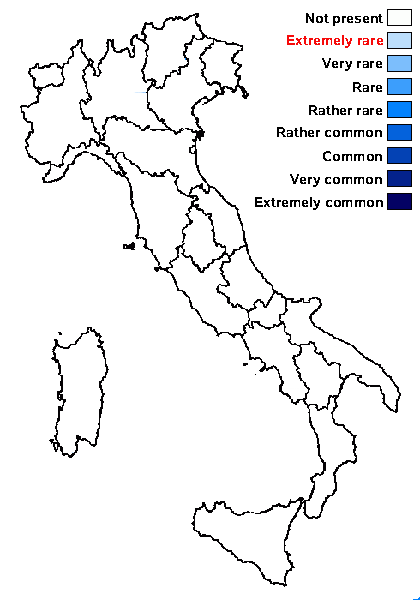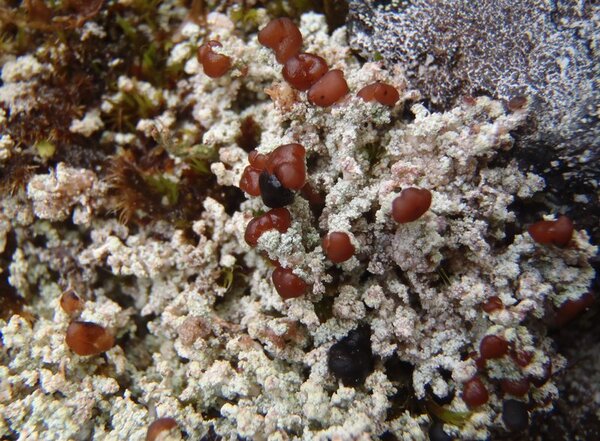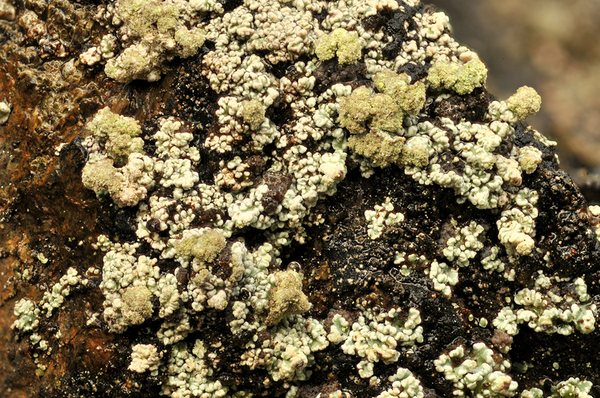Stereocaulon symphycheilum I.M. Lamb
Bot. Notiser, 114, 3: 271, 1961.
Synonyms:
Distribution:
Description: Primary thallus crustose, ephemeral, usually absent in mature individuals, secondary thallus fruticose. Pseudopodetia firmly attached to the rock, decumbent, clearly dorsiventral, up to 1.5(-2) cm tall, lacking tomentum, whitish or greyish, branched in upper part, with a solid cartilaginous axis of parallel hyphae surrounded by a lax medulla, mainly tipped by conspicuous, globose, capitate soralia, the soredia farinose or granulose, greenish white to grey. Phyllocladia on upper part of pseudopodetia, grey-green, peltate, flattened or concave, at least some of them with a dark olive-coloured central part and paler margins (resembling those of S. vesuvianum). Cephalodia dark brown-black, with a rough surface, containing Stigonema, mostly located in the lower part of pseudopodetia. Apothecia rare, terminal, 1-2.5 mm across, with a dark brown disc. Proper exciple brown in outer part, colourless within; epithecium brown, K-; hymenium colourless, 50-60 µm high; paraphyses simple or sparingly branched, 1-2 µm thick at mid-level, the apical cells 3-4 µm wide, with a dark cap; hypothecium colourless. Asci (4-)6-8-spored, cylindrical-clavate, with a K/I+ blue outer layer and apical dome, and a central, K/I+ darker blue tube, Porpidia-type. Ascospores 3-septate, hyaline, elongate-fusiform, 20-35 x 3-4.5 µm. Pycnidia rare. Conidia 1-celled, hyaline, straight or slightly curved, bacilliform c. 4.5 x 0.7 µm. Main photobiont chlorococcoid. Spot tests: thallus K+ yellow, C-, KC- or KC+ violet (reaction often difficult to observe macroscopically, best evident on acetone extract on filter paper!), P+ faintly yellow, UV+ blue-white. Chemistry: atranorin and lobaric acid. Note: a circum-arctic-alpine, sorediate, silicicolous species with a few records from the Eastern Alps only (Austria), but perhaps more widespread, and hidden behind some of the Alpine records of S. vesuvianum; to be looked for in the Italian Alps.
Growth form: Fruticose
Substrata: rocks
Photobiont: green algae other than Trentepohlia (primary); cyanobacteria, filamentous (e.g. Nostoc, Scytonema) (secundary, e.g. in cephalodia)
Reproductive strategy: mainly asexual, by soredia, or soredia-like structures (e.g. blastidia)
Commonnes-rarity: (info)
Alpine belt: extremely rare
Subalpine belt: extremely rare
Oromediterranean belt: absent
Montane belt: absent
Submediterranean belt: absent
Padanian area: absent
Humid submediterranean belt: absent
Humid mediterranean belt: absent
Dry mediterranean belt: absent

Predictive model
Growth form: Fruticose
Substrata: rocks
Photobiont: green algae other than Trentepohlia (primary); cyanobacteria, filamentous (e.g. Nostoc, Scytonema) (secundary, e.g. in cephalodia)
Reproductive strategy: mainly asexual, by soredia, or soredia-like structures (e.g. blastidia)
Commonnes-rarity: (info)
Alpine belt: extremely rare
Subalpine belt: extremely rare
Oromediterranean belt: absent
Montane belt: absent
Submediterranean belt: absent
Padanian area: absent
Humid submediterranean belt: absent
Humid mediterranean belt: absent
Dry mediterranean belt: absent

Predictive model
 INDEX FUNGORUM
INDEX FUNGORUM
 GBIF
GBIF




